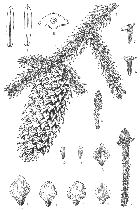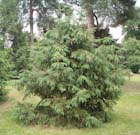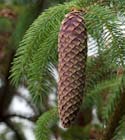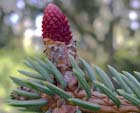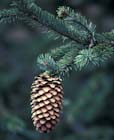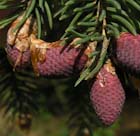for the species:

for var. rubescens:

for var. linzhiensis:

for var. hirtella:

for var. montigena:

Picea likiangensis
(Franchet) E. Pritzel 1900
Common names
Lijiang spruce; 丽江云杉 Lijiang yunshan [Chinese].
Taxonomic notes
Syn: Abies likiangensis Franch.; Picea yunnanensis hort. ex Wilson. Four varieties here recognized (all from Farjon [1990]):
Picea likiangensis var. rubescens Rehder & Wilson (syn: P. balfouriana Rehder & Wilson; Picea likiangensis var. balfouriana (Rehder & Wilson) Slavin; P. sikangensis Cheng; P. balfouriana f. bicolor Cheng).
Picea likiangensis var. hirtella (Rehder & Wilson) Cheng ex Chen (syn: P. hirtella Rehder & Wilson; P. balfouriana var. hirtella (Rehder & Wilson) Cheng).
Picea likiangensis var. linzhiensis W.C. Cheng & L.K. Fu (syn: P. linzhiensis (W.C. Cheng & L.K. Fu) Rushforth 2007; P. likiangensis var. linzhiensis f. bicolor Cheng et Fu).
Picea likiangensis var. montigena (Masters) Chenx ex Chen (syn: P. montigena Masters).
Lockwood et al. (2013), in their molecular phylogeny of Picea, placed the type variety and vars. hirtella, linzhiensis and rubescens together in a clade sister to P. farreri. Their analysis did not consider var. montigena. Their molecular clock analysis estimated divergence of vars. linzhiensis and rubescens during Pleistocene time, with divergence of vars. likiangensis and hirtella a bit earlier, in Pliocene time. Based largely on this result I am retaining var. linzhiensis as a variety, despite Rushforth's (2007) argument that it is sufficiently intermediate in form between P. likiangensis and P. spinulosa, and has sufficient ecological differentiation from the other varieties, to warrant species rank. Rushforth also makes the interesting point that var. montigena may be a hybrid between P. likiangensis and P. asperata; as almost nothing is known of this variety, its status must be regarded as tentative. Rushforth (2007) also erects a P. likiangensis (Franchet) E. Pritz. subsp. balfouriana (Rehder & Wilson) Rushforth that unites var. rubescens and var. hirtella in a single subspecies, but this combination, as noted, is also unsupported in the molecular analysis of Lockwood et al. (2013), and Rushforth's argument that the differences between the two varieties are "slight" differs from the assessments by Wu and Raven (1999) and Farjon (2010), who found those differences sufficiently consistent to warrant taxonomic distinction.
Jean Hoch (2019) maintains that "very clear taxonomic differences" distinguish Picea sikangensis as a taxon distinct from P. likiangensis var. rubescens in Sichuan, and posts photos from Sichuan. I lack sufficient information to comment, but note that Hoch is a widely respected conifer botanist.
Description
Trees to 50 m tall and 250 cm dbh, with a pyramidal crown. Bark gray or brown-gray, breaking into thick, irregular plates. Branchlets initially pale yellow or brownish yellow, turning gray or gray-yellow, sparsely pubescent. Leaves directed forward on upper side of branchlets, spreading on lower side, linear, straight or slightly curved, rhombic in cross section, 6-15×1-1.5 mm, with 4-7 stomatal lines on the upper and 0-4 on the lower surface, apex acute or obtuse. Seed cones maturing shades of red, brown, or dark purple, ovoid-cylindric, 4-12×1.7-3.5 cm when open. Seed scales rhombic-ovate, 15-26×10-17 mm, margin denticulate or undulate. Seeds gray-brown, subovoid, 7-14 mm including a pale brown wing with purplish spots. Pollination Apr-May, seed maturity Sep-Oct (Wu and Raven 1999).
Distribution and Ecology
Bhutan; China: S Qinghai, S and W Sichuan, E Xizang (Tibet), NW Yunnan, at 2500-4100 m elevation (Wu and Raven 1999). Hardy to Zone 8 (cold hardiness limit between -12.1°C and -6.7°C) (Bannister and Neuner 2001).
Remarkable Specimens
The oldest known living specimen, 589 years, was documented in a tree-ring chronology covering the period 1406-1994 (crossdated after 1448), collected in southeastern Tibet by Achim Brauning (doi.org/10.25921/6wpw-0t84). This chronology was used in a dendroclimatic temperature reconstruction (PAGES 2k Consortium 2013).
Ethnobotany
Observations
Can easily be found in mountain valleys in the vicinity of Kangding, Sichuan, where are found the type locales for several varieties first collected by E.H. Wilson (Farjon 1990).
Remarks
The epithet refers to the mountains near Lijiang in Yunnan, where Delavay collected the type (Franchet 1899).
Var. montigena is "a useful timber tree restricted to a small area of high-altitude coniferous forest in south-west Sichuan. Levels of exploitation of both the tree and the forest in general have caused population declines. There are no signs of the pressure easing and no protection measures are enforced." Var. hirtella is "restricted to high-altitude coniferous forests in the mountains of west Sichuan and neighbouring Tibet. The tree provides a useful timber and levels of exploitation of both it and the forest in general have caused serious habitat fragmentation and population declines" (WCMC 1998).
Citations
Farjon, Aljos. 1990. Pinaceae: drawings and descriptions of the genera Abies, Cedrus, Pseudolarix, Keteleeria, Nothotsuga, Tsuga, Cathaya, Pseudotsuga, Larix and Picea. Königstein: Koeltz Scientific Books.
Franchet, A. 1899. Plantarum sinensium ecloge tertia. Journal de Botanique 13:257. Available: Biodiversity Heritage Library, accessed 2020.11.26.
Hoch, Jean. 2019.02.18. Post in Facebook group "Planet Conifer." https://www.facebook.com/groups/planetconifer/permalink/2528188983877740/, accessed 2019.02.18.
Lockwood, Jared D., Jelena M. Aleksic, Jiabin Zou, Jing Wang, Jianquan Liu, and Susanne S. Renner. 2013. A new phylogeny for the genus Picea from plastid, mitochondrial, and nuclear sequences. Molecular Phylogenetics and Evolution 69:717-727.
PAGES 2k Consortium. 2013. Continental-scale temperature variability during the past two millennia. Nature Geoscience 6:339-346. doi: 10.1038/NGEO1797
Pritzel, E. 1901. Bot. Jahrb. Syst. 29:217. Available: Biodiversity Heritage Library, accessed 2020.11.26.
Rushforth, K. 2007. Spruces (Picea: Pinaceae) in the Yarlung Tsangpo drainage of southeast Tibet (Xizang, China). International Dendrology Society Yearbook 70:42–53.
World Conservation Monitoring Centre - Trees [WCMC]. 1998. Database at http://www.wcmc.org.uk/cgi-bin/SaCGI.cgi/trees.exe, accessed 1998.10.01, now defunct.
See also
The species account at Threatened Conifers of the World.
Zhuoxuan Lu, Yuhua Wang, Xiaolu Zhang, Helena Korpelainen, and Chunyang Li. 2009. Genetic variation of isolated Picea balfouriana populations from the southeast of the Qinghai-Tibet Plateau. Annals of Forest Science 66:607-616.
